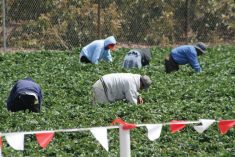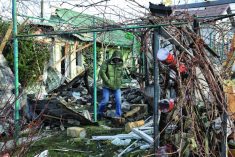Seeding this spring is going to be a little like the Indianapolis 500.
No matter which seed you plant, you’ll probably cross the finish line — but you’re going to get there a whole lot faster in a Lamborghini than a LeBaron.
Seed with both high germination and high vigour will help you win the race, but like a Lamborghini, that seed is going to be a luxury — one that’s pricy and hard to find.

“With the way germination issues have been across the province, guys might have a hard time finding particular varieties that they might want,” said Renee Hoyme, a seed grower from Thorhild.
“I don’t foresee it being an easy year to source a lot of seed.”
Last year’s growing conditions turned 2018 into a tough growing season for Alberta farmers, including seed growers who struggled to get a high-quality crop off following a smoky summer, wet fall, and early winter. As a result, seed growers had well-above-average grade losses as well as issues with germination, dormancy, and vigour.
“It’s been the third year in a row of bad years for harvest,” said Hoyme, the recently elected president of Alberta Seed Growers.
Read Also

Farming Smarter receives financial boost from Alberta government for potato research
Farming Smarter near Lethbridge got a boost to its research equipment, thanks to the Alberta government’s increase in funding for research associations.
“We got three big snowfalls on unharvested crops, and that really kicked the germination in our seed.”
Ideally, germination in seed should be sitting between 90 and 95 per cent (which means that of 100 seeds planted, at least 90 will germinate). But because of last year’s poor growing conditions, germination is closer to the 80 to 85 per cent range for a good chunk of the seed out there.
So some farmers will have to settle for lower-quality seed.
“Our germination isn’t as high as we would like it to be,” said Hoyme. “Buyers will have to have realistic expectations around what they’re getting for seed.”
‘Know what you sow’
And the best way to do that is by seed testing, said Shauna Sereda, a seed analyst at 20/20 Seed Labs.
“You have to know what you sow,” Sereda said at a recent Seedgrowth Solutions Expo. “You want high-quality seed going into the season, so you need to know what you have. Germination testing is $28, and then at least you know what you’re going into seeding with.”
Testing is worth it whether farmers are buying from a seed grower or planting what they have in the bin.
“This past year has really stressed a lot of farmers. They’re thinking their seed must be bad,” said Sereda. “There’s a lot of dormancy, and even if the germination might be good, the vigour might be low. But there’s stuff that’s really good out there when it’s tested.”
Ideally, producers should test not only for germination, but vigour as well.
“A vigour test will tell you how strongly your seed is going to perform in those cold spring conditions,” said Sereda. “It gives you a lot more information.”
That’s becoming increasingly important given the cold, wet springs farmers have been seeing in recent years, said Hoyme.
“With the way our springs have been going, I think vigour plays a more important role now that we’ve got different conditions that we’re dealing with in the springtime.”
Dormancy is another problem in a year like this one, where the growing conditions have created a stress response in the seed, she added.
“Dormant seeds aren’t dead — they’re ready to grow, but they’re just sitting there not doing anything,” said Sereda. “Guys who sent their seed in, in the fall had high dormancy, but when we started with dormancy breakers, believe it or not, the seed was actually germinating very well.
“But it takes a few months to break. Right now, we can’t tell when that dormancy will come out by itself.”
That’s why farmers should be testing their seed before they head into spring, said Hoyme.
“Seed testing should be a given on any year, but this year, it’s essential,” she said. “With our dormancy issues, we’ve tested our seed lots about three times already since the fall just to make sure that we’re getting to a place where our seed will make germination.
“It’s a tool we use as seed growers every year, and I highly recommend producers do too — and not just because it’s a bad year this year for germination. They should be testing every year.”
Sample properly
Seed-testing facilities such as 20/20 Seed Labs typically offer a variety of tests using either DNA or plate cultures (or both). But every test starts with a good representative sample from the bin.
“Don’t go to your bin doors, scoop a little bit out, and send it in thinking that that’s going to be representative of what’s in your bin,” said Sereda.
“Doors are the worst places to take your samples from. It freezes and thaws and freezes and thaws. I know it’s hard, but probes are great. You’ll get a much better representative sample with a probe.”
Producers buying from a seed grower should ask for the lab test results before they close the deal.
“It’s your responsibility to be an informed purchaser, and it’s our responsibility as seed growers to give you that information,” said Hoyme. “It will give you a little more knowledge on how to manage your seeding.”
However, farmers will need to book early if they hope to get the seed they want for the upcoming growing season.
“I know it’s getting kind of late, but it’s important to source your seed as early as possible,” said Hoyme. “When you push it to two or three weeks before seeding, it might be pretty hard to get the seed that you want.”















